We peek ahead to see what comets await us in 2019. Bright ones will be sparse, but several nice objects, including Comet Iwamoto (C/2018 Y1) and Comet Africano (C/2018 W2), will keep things lively.
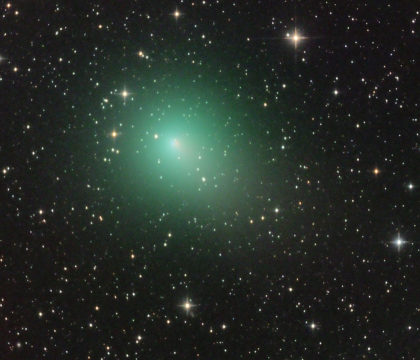
José J. Chambó
We start the new year with a nice assortment of slightly used comets left over from 2018. Enjoy them while you can, as 2019 won't be as generous with its comet candy. While a dozen or more comets are visible in most years, the majority are on the dim side, little misty spots of magnitude 11 and fainter. In the magnitude 10.5 and brighter category — those within range of a 8-inch telescope from somewhat light-polluted skies — there are currently five easily accessible comets. Let's start with the brightest and work from there.
46P/Wirtanen
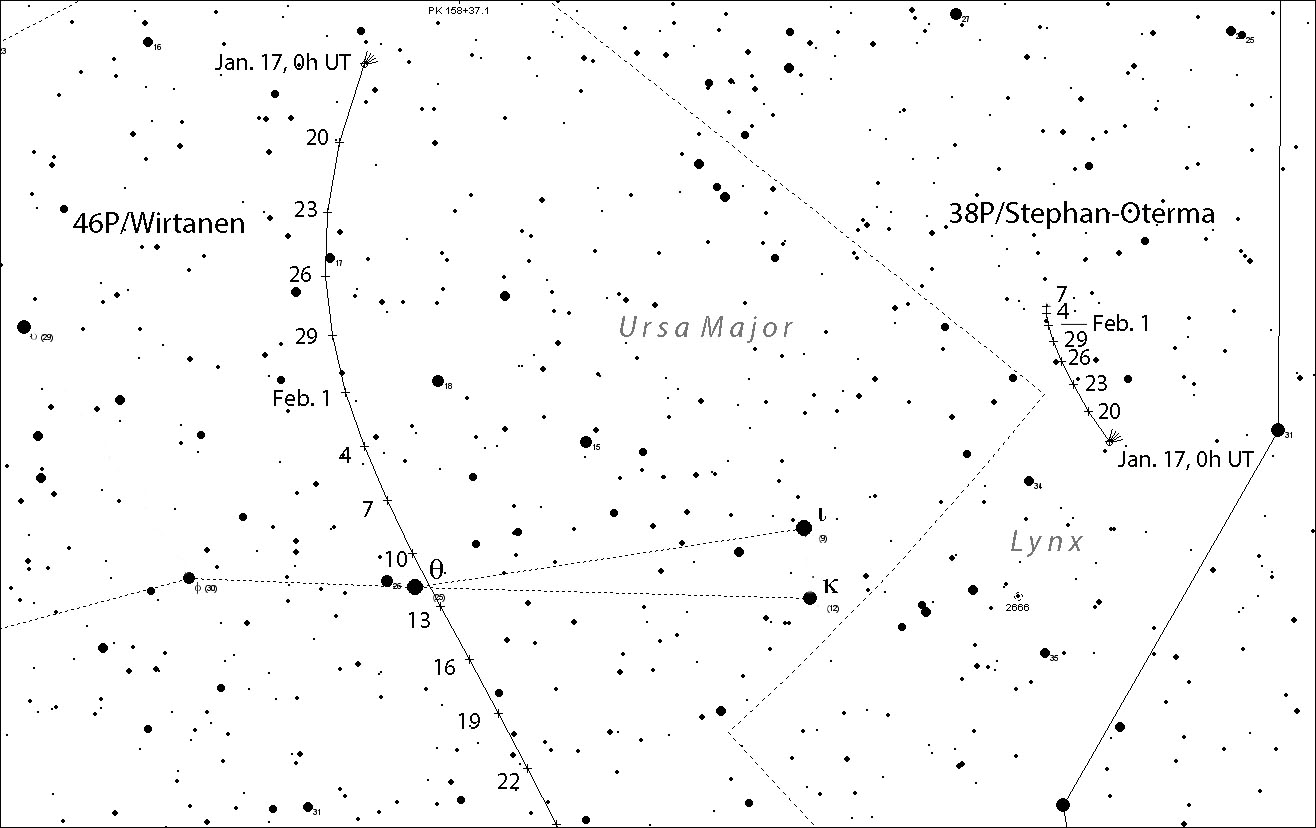
Chris Marriott's SkyMap with additions by the author
Lots of us got to enjoy great views of Comet 46P/Wirtanen last month. Visible with the naked eye from dark skies, it reached 4th magnitude, about what was predicted. Now glowing around magnitude 7 and fading, I easily spotted it in 10×50 binoculars on January 16.5 UT from a dark sky as a fuzzy glow about 15′ across with a slightly brighter center. Through my 15-inch (37-cm) Dob I could see the elongated coma if I rocked the scope around and used averted vision. Comet 46P's apparent motion has slowed considerably from a couple weeks ago. Look for it now in Ursa Major where it will continue to fade from 7th to 12th magnitude by mid-March.
38P/Stephan-Oterma
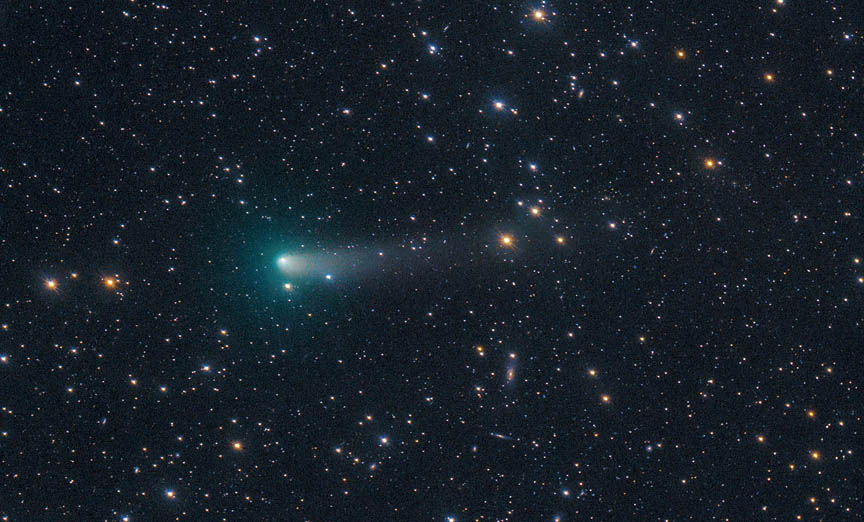
Michael Jäger
This midge of a comet is crawling across Lynx, only a stone's throw from 46P/Wirtanen. On January 16th, the two comets are 14° apart and close to within 11.3° on February 12th. Catch 38P now because it's fading away like the rest of its brethren. Through my 15-inch scope on January 5.1 UT, I noted a small, moderately condensed, magnitude-10.5 coma 1.5′ (arcminute) wide and at 64× magnification. Upping to 142× and 245×, I faintly made out a short, stubby tail extending to the west with averted vision.
64P/Swift-Gehrels
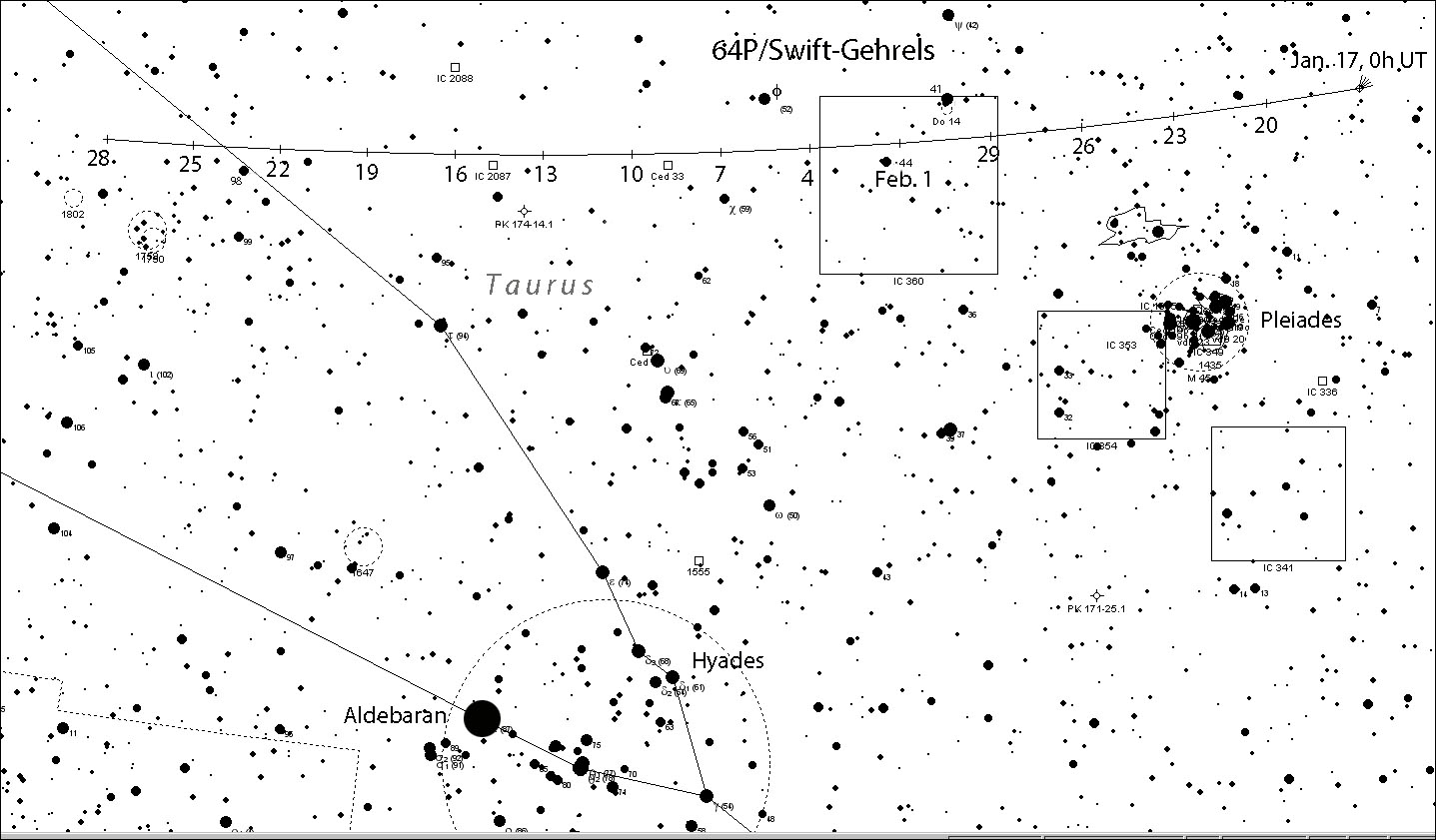
Chris Marriott's SkyMap with additions by the author
Our third periodic comet of the season is also fading but still glows around magnitude 10.5 and is currently well-placed in Taurus at nightfall. This is a very diffuse object with a degree of condensation (DC) of 3 on a scale from "0" (no compaction) to "9" (star-like). The coma measures about 4′ across. Some observers put the comet at magnitude 9.5, but I estimated magnitude 10 during an early January observing session. A Swan Band filter helps to boost contrast and visibility.
PanSTARRS (C/2016 M1)
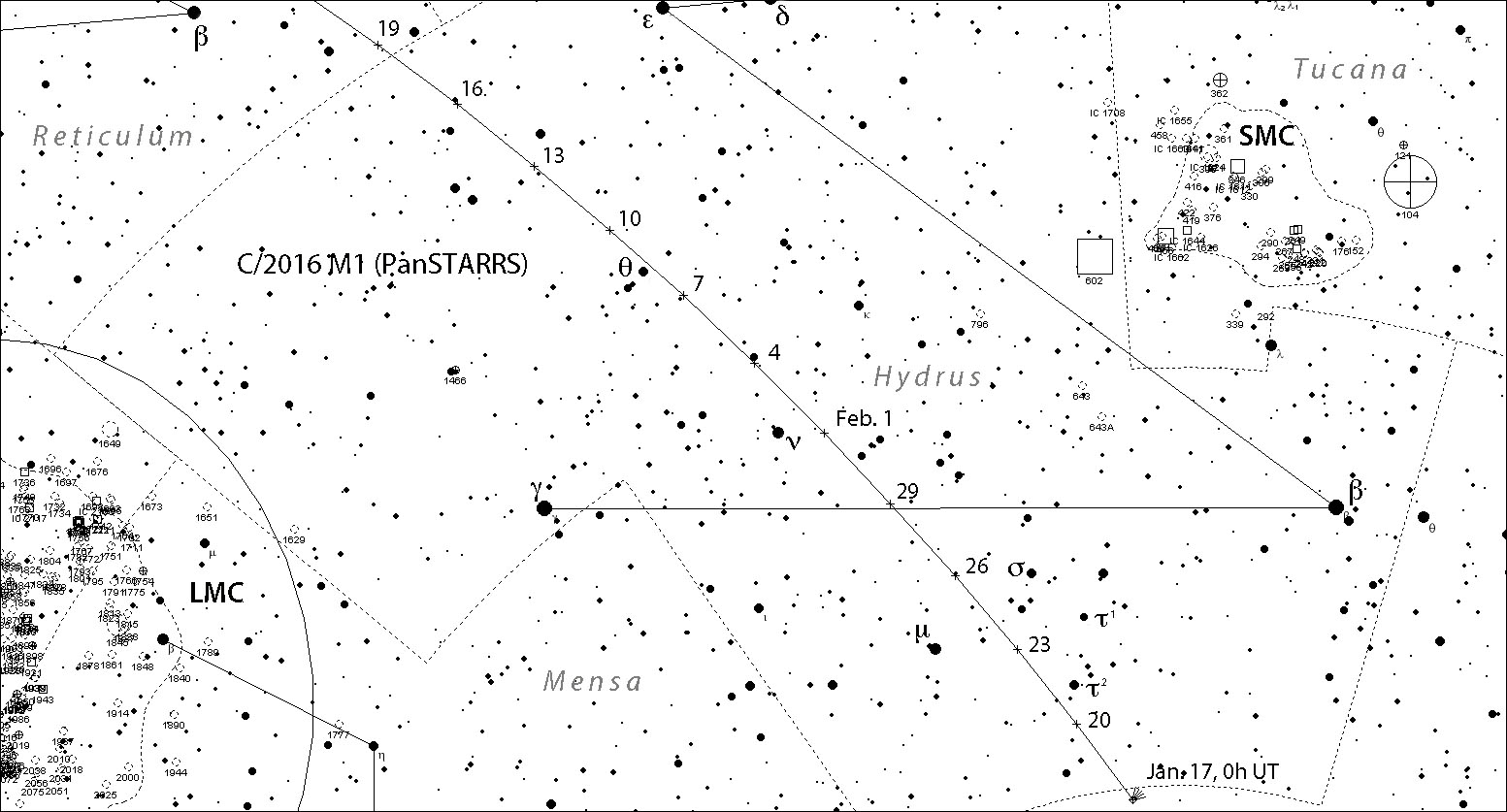
Chris Marriott's SkyMap with additions by the author
This PanSTARRS comet reached 8th magnitude last June, and it's still an easy object at about magnitude 10.5 with a 4′, moderately condensed (DC=4) coma, but is only visible from the Southern Hemisphere. An 8-inch should give a good view once the Moon is out of the sky. The comet moves steadily northeast across Hydrus in the coming weeks and slowly fades.
Iwamoto (C/2018 Y1)
Look what we have here — a comet that's not fading. Japanese amateur Masayuki Iwamoto found this object on images taken December 18.8 UT (2018). Following Comet Machholz-Fujikawa-Iwamoto (C/2018 V1) (co-discovered by Donald Machholz and Shigehisa Fujikawa) and Iwamoto (C/2013 E2), this was his third discovery. In December, the comet glowed dimly at around magnitude 11.5, but now (in mid-January) it's a hair brighter than magnitude 10.
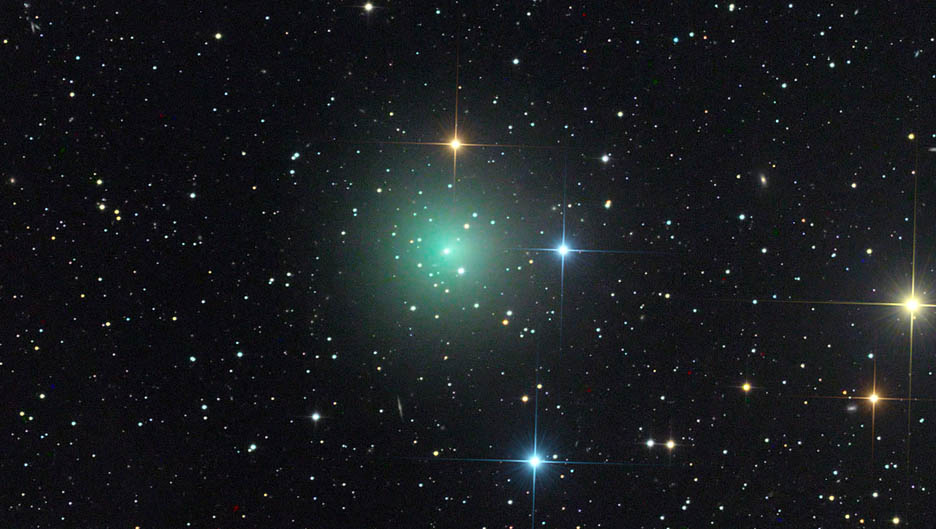
Rolando Ligustri
Although still low in the sky for northern observers and soon to be fighting moonlight, Iwamoto is climbing higher every night and brightening. Currently in southern Virgo and well-placed from 3 a.m. till dawn local time, the comet will be visible as soon the Moon gets out of the way starting the 29th. I caught it on January 16.5 UT in my 15-inch at 64× magnification through modest light pollution and saw a puffy glow about 6′ wide with a slightly brighter central region (DC=2). The view improved significantly with the addition of the Swan Band filter.
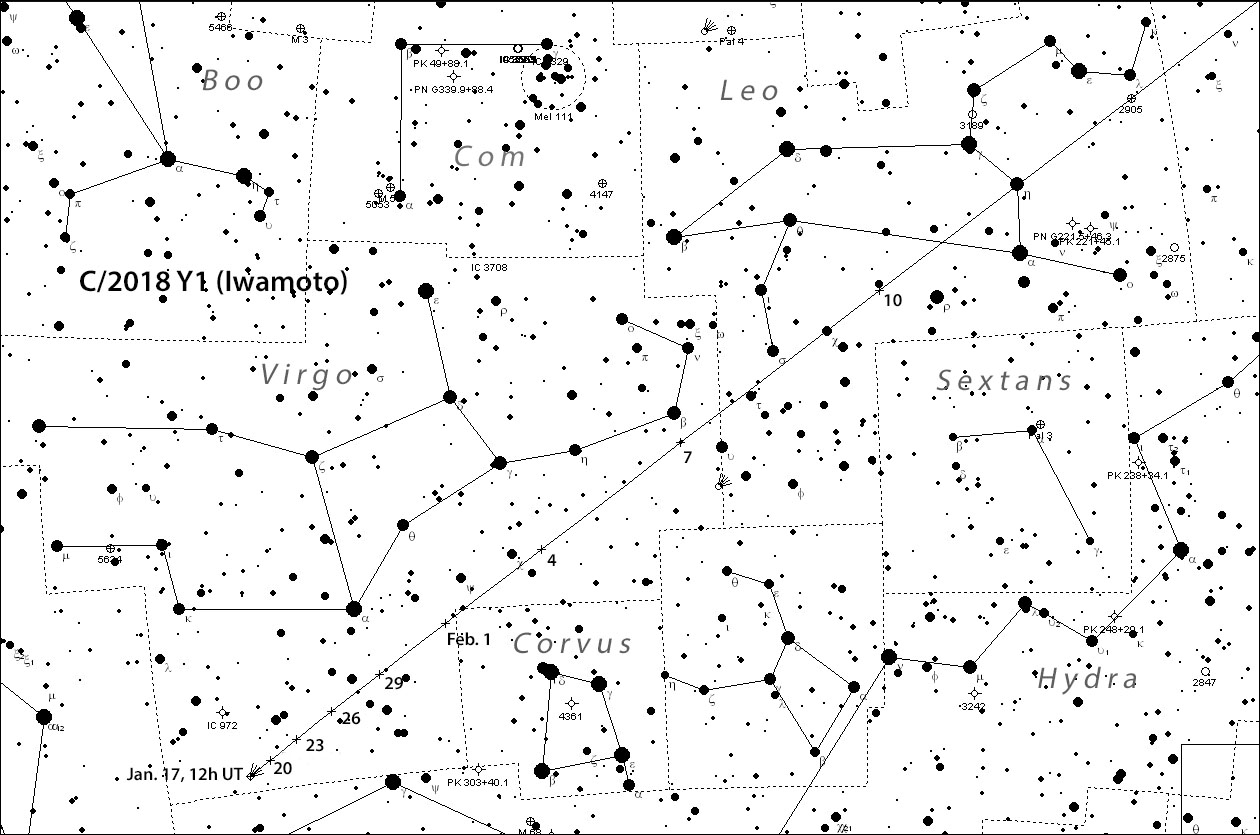
Chris Marriott's SkyMap with additions by the author
If predictions bear fruit, the comet could become as bright as magnitude 7 when it swings 0.3 a.u. from Earth on February 12th, just 6 days after perihelion. And get this — on that date, it will sit bright and pretty in the Sickle of Leo with the Moon at first quarter. For a few evenings around that time, the comet's apparent speed will average 7° to 8° per day or nearly 20′ per hour! Are you excited? Yeah, me too.
29P/Schwassmann-Wachmann
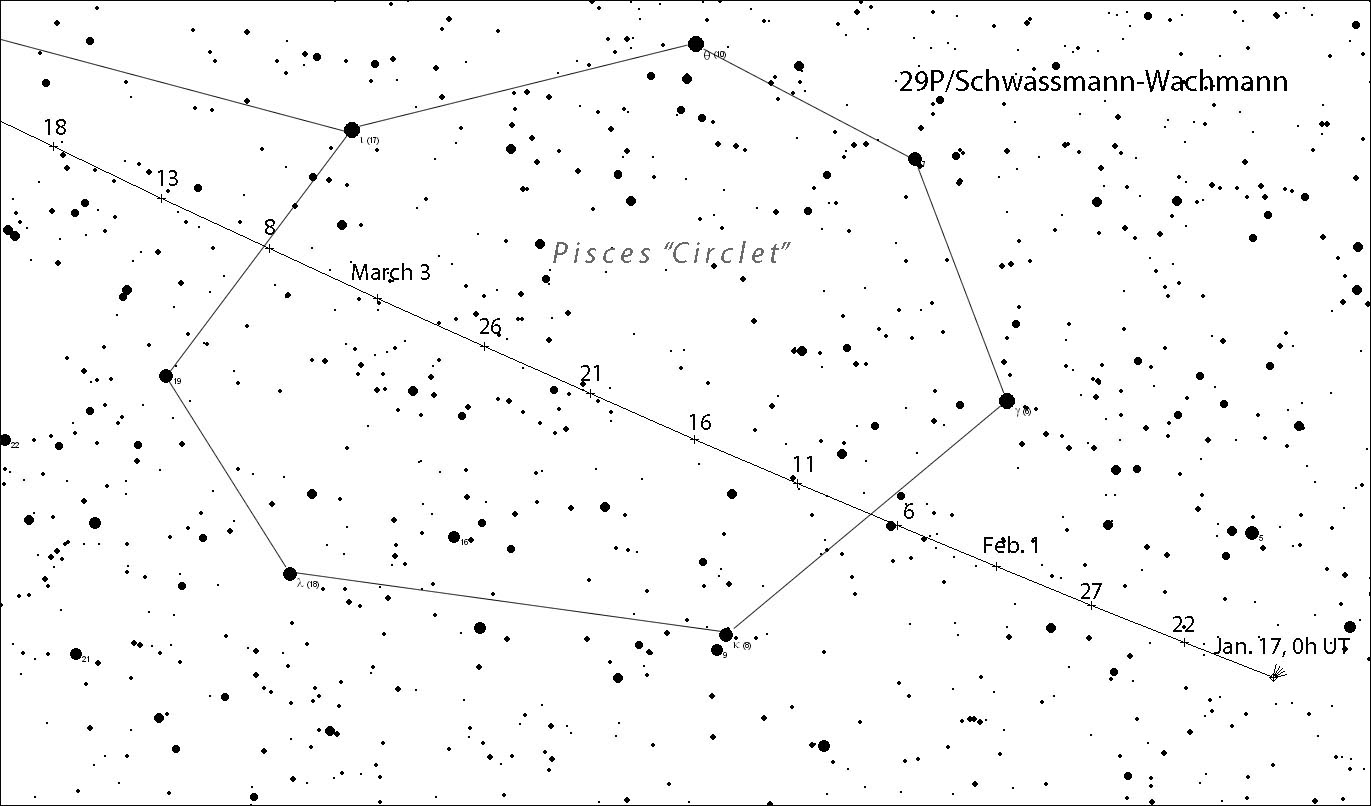
Chris Marriott's SkyMap with additions by the author
Everybody's favorite comet to pronounce, 29P/S-W1 hangs in western Pisces where it will be observable through mid-February. After conjunction with the Sun in mid-March, it returns to the morning sky in late May, still moving east in Pisces. The famed comet is subject to outbursts at any time, which can raise its nominal magnitude of 14–15 to as bright as 10.5. The cause of the outbursts may be due to pressurized pockets of carbon monoxide and methane beneath the crust that erupt explosively as cryovolcanoes due to solar heating. If you happen to catch 29/S-W early in an outburst, it often looks like a bright, compact planetary nebula. To keep tabs on it so you don't miss the show, subscribe to the Comets Mailing List.
Africano (C/2018 W2)
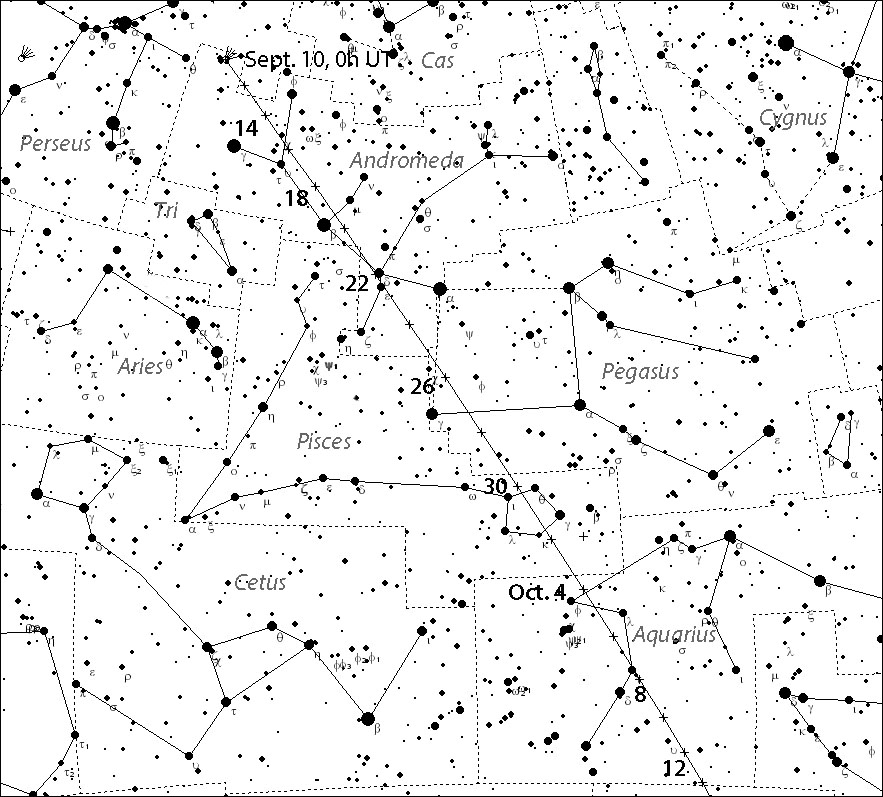
Chris Marriott's SkyMap with additions by the author
Discovered on November 27, 2018, by B. M. Africano (Mount Lemmon Survey) as a 20th-magnitude fuzzy blip with a possible tail, this comet reaches perihelion on September 6th, when it could peak around magnitude 9. Expect to coax it into view around magnitude 10.5 in early September in far eastern Andromeda, where it will be conveniently placed for evening viewing. By late September, C/2018 W2 hurries across Pegasus, Pisces, and into Aquarius before putting the brakes on in Piscis Austrinus in mid-October. During that time it may brighten to magnitude 9.5 but just as soon fades back to 10.5 later that month. Viewing should be best from about September 17–October 7 when the Moon is out of view.
PanSTARRS (C/2017 T2)
Although this comet won't reach perihelion until 2020, it's expected to brighten to magnitude 10.5 by late November, when it will be conveniently situated near the bright star Capella in Auriga. Traveling west into Perseus and then Cassiopeia, it may reach magnitude 9.5 by year's end. Not exactly the Christmas comet 46P/Wirtanen was, but any comet visible in a 6-inch telescope is a gift.
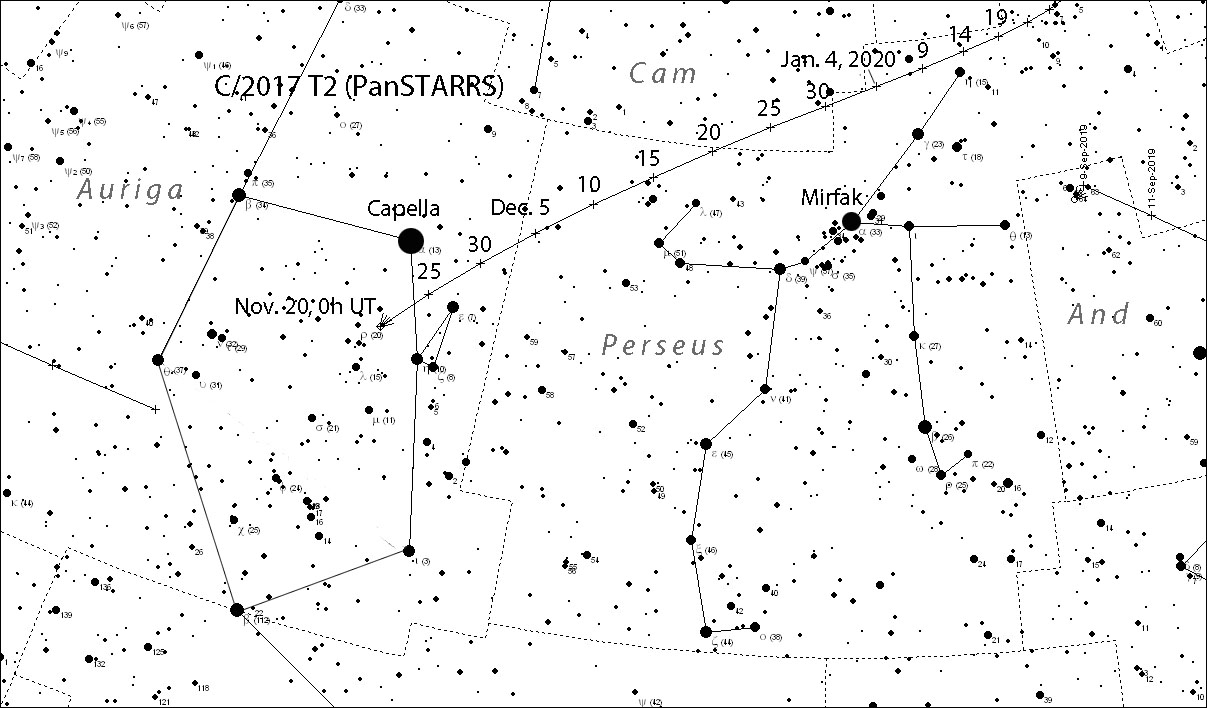
Chris Marriott's SkyMap with additions by the author
Fainter stuff
You can see we have a number of good targets early this year with Iwamoto (C/2018 Y1) spicing things up this month and next. But assuming no new bright discoveries or telescope-toppling outbursts from 29P/S-W1, we enter the cometary horse latitudes until September. Cometophiles will surely suffer from withdrawal, the reason we need to cross our fingers for a new discovery. I'm confident there will be several.
The following comets should reach between magnitude 12 and 14, putting them within range of 10-inch or larger telescopes. For additional information on these dimmer objects, click here. For recent comet observations and magnitudes, please check out Jure Zakrajšek excellent Comet Observers Database. If you can't make your own custom finder maps, you can always get current maps for many comets here:
- 123P/West-Hartley — Winter — Located in southern Ursa Major and currently undergoing a small outburst. The 13.5-magnitude comet is about 1′ across and moderately condensed. In my 15-inch on January 16.5 UT, it was a tiny patch with a very compact, bright core.
- 78P/Gehrels — Winter — Magnitude 13 and slowly moving east through Pisces.
- 60P/Tsuchinshan — Winter — Magnitude 13.5 and slowly moving west across southern Leo.
- 68P/Klemola — Summer — For much of the summer it will loll about in central Ophiuchus around magnitude 13.5 before fading and moving southeast.
- 168P/Hergenrother — Summer — I've seen estimates of magnitude 11 from July through September, but my software says no brighter than magnitude 17. We'll see.
- PanSTARRS (C/2016 R2) — Late summer, early fall — A 14th-magnitude smudge from August through October moving north from Aries into Perseus.
- ASASSN (C/2018 N2) — Late summer, early fall — Located in Aries at ~13.5 magnitude in mid-August, then brightening to ~12.5 magnitude as it heads northwest across Triangulum and Andromeda in early October.
 5
5








Comments
Richard-Lighthill
January 17, 2019 at 1:06 pm
Thanks, Bob, for the updates on these comets!
You must be logged in to post a comment.
Bob KingPost Author
January 17, 2019 at 8:15 pm
You're welcome, Richard. I hope you get to see them. I was pleasantly surprised to find 46P the other night in binoculars. I'm having a hard time letting go of that one!
You must be logged in to post a comment.
Joe Stieber
February 2, 2019 at 1:11 pm
Regarding C/2018 Y1 (Iwamoto), I finally had a solid sighting on January 30, 2019, about 4:30 am EST, from the New Jersey Pines with my 16x70 binoculars. It was not difficult to locate and see the small fuzzy spot... easier to see than nearby M104. However, I think your chart for Iwamoto needs an update. My sighting on Jan 30 was near the position for Feb 5 on your chart. SkySafari had it in the right spot, matching the position I saw in my binoculars and an 85 mm spotting scope, and where it was in a snapshot I took. For tomorrow morning, Feb 3, SkySafari has it near your chart’s position for Feb 11. I’m hoping to get out for a look and to verify the position (if the weather cooperates).
You must be logged in to post a comment.
Joe Stieber
February 3, 2019 at 6:45 pm
I was out for a look this morning, Sunday, February 3, 2019, and Iwamoto was easy to see in my 15x56 binoculars from East Point, NJ, overlooking the Delaware Bay (I also got a view of Omega Centauri, from 39.2°N). The comet was in the same binocular field as M104 (the Sombrero Galaxy). It was indeed in the position indicated for Feb 11 on the chart here. I have also noticed that the current chart has Iwamoto under Virgo on Feb 12 while the text of the article indicates it will be in Leo’s Sickle on Feb 12 (which is where SkySafari puts it on the evening of Feb 12). Yes, the Iwamoto chart needs an update!
You must be logged in to post a comment.
Bob KingPost Author
February 4, 2019 at 7:32 am
Hi Joe,
Last night I realized the chart needed to be updated with new elements. Then this morning I saw your note — thank you for also noticing! We're good now 🙂
You must be logged in to post a comment.
You must be logged in to post a comment.